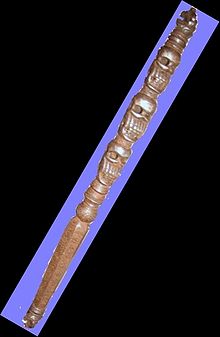| This article needs additional citations for verification. Please help improve this article by adding citations to reliable sources. Unsourced material may be challenged and removed. Find sources: "Khaṭvāṅga" – news · newspapers · books · scholar · JSTOR (November 2016) (Learn how and when to remove this message) |
| Khatvanga | |
|---|---|
 Khatvanga Khatvanga | |
| Devanagari | खट्वाङ्ग |
| Sanskrit transliteration | Khaṭvāṅga |
A khaṭvāṅga (Sanskrit: खट्वाङ्ग) is a long, studded staff or club originally understood as Shiva's weapon. It evolved as a traditional ritualistic symbol in Indian religions and Tantric traditions like Shaivism, and in the Vajrayana of Tibetan Buddhism. The khatvānga was also used as tribal shaman shafts.
Hinduism

In Hinduism, Shiva-Rudra carried the khatvāṅga as a staff weapon and are thus referred to as khatvāṅgīs. Author Robert Beer says, "In Hinduism the khatvanga is an emblem or weapon of Shiva, and is variously described as a skull - topped club, a skull - mounted trident, or a trident - staff on which three skulls are impaled".
Author A. V. Narasimha Murthy says, "In classical literature the weapon Khatvanga is mentioned in works like Mālatīmādhava of Bhavabhuti and Śiva Stutī of Narayana Panditacharya".
Fabrication
Originally, the khatvāṅga was made of bones, especially, the long bones of forearm or the leg of human beings or animals. Later, wood and metal were used. The khatvāṅga is a long club with skulls engraved on the body.
Vajrayana Buddhism

Author Robert Beer states that "The form of the Buddhist khaṭvāṅga derived from the emblematic staff of the early Indian Shaivite yogis, known as kapalikas or "skull-bearers". The kapalikas were originally miscreants who had been sentenced to a twelve-year term of penance for the crime of inadvertently killing a Brahmin. The penitent was prescribed to dwell in a forest hut, at a desolate crossroads, in a charnel ground, or under a tree; to live by begging; to practice austerities; and to wear a loin-cloth of hemp, dog, or donkey-skin. They also had to carry the emblems of a human skull as an alms-bowl, and the skull of the Brahmin they had slain mounted upon a wooden staff as a banner. These Hindu kapalika ascetics soon evolved into extreme outcaste adherents of the "left-hand" Tantric path (Sanskrit: Vāmamārga) of shakti or goddess worship. The early Buddhist tantric yogins and yoginis adopted the same goddess or dakini attributes of the kapalikas. These attributes consisted of; bone ornaments, an animal skin loincloth, marks of human ash, a skull-cup, damaru, flaying knife, thighbone trumpet, and the skull-topped Tantric staff or khaṭvāṅga".
Robert Beer relates how the symbolism of the khatvāṅga in the Vajrayana of Tibetan Buddhism, particularly the Nyingma school founded by Padmasambhava, was a direct borrowing from the Shaiva Kapalikas, who frequented places of austerity such as charnel grounds and crossroads as a form of "left-handed path" (vamachara) sādhanā. In Padmasambhava's iconographic representations, the khatvanga represents his scribe, biographer and spiritual consort Yeshe Tsogyal. The weapon's three severed heads denotes moksha from the three worlds (Trailokya); it has a rainbow sash representing the Five Pure Lights of the mahābhūta.
References
- Robert Beer (1999). The Encyclopedia of Tibetan Symbols and Motifs. Serindia Publications. p. 250. ISBN 9780906026489.
- A. V. Narasimha Murthy (2001). Hemakuta: Recent Researches in Archaeology and Museology : Shri C.T.M. Kotraiah Felicitation Volume, Volume 1. Bharatiya Kala Prakashan. p. 160. ISBN 9788186050484.
- Beer, Robert (2003). The handbook of Tibetan Buddhist symbols. Serindia Publications. p. 102. ISBN 1-932476-03-2. Retrieved February 3, 2010.
- ^ Beer, Robert (2003). The handbook of Tibetan Buddhist symbols. Serindia Publications. p. 102. ISBN 1-932476-03-2. Retrieved February 3, 2010.